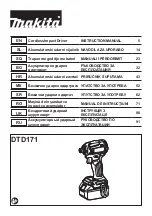
6
Fig.7
Move the O-ring out of the groove in the socket and
remove the pin from the socket. Fit the socket onto
the anvil of the tool so that the hole in the socket is
aligned with the hole in the anvil. Insert the pin
through the hole in the socket and anvil. Then return
the O-ring to the original position in the socket
groove to retain the pin. To remove the socket,
follow the installation procedures in reverse.
Hook
Fig.8
The hook is convenient for temporarily hanging the tool.
This can be installed on either side of the tool.
To install the hook, insert it into a groove in the tool
housing on either side and then secure it with a screw. To
remove, loosen the screw and then take it out.
OPERATION
CAUTION:
•
Always insert the battery cartridge all the way until it
locks in place. If you can see the red part on the
upper side of the button, it is not locked completely.
Insert it fully until the red part cannot be seen. If not,
it may accidentally fall out of the tool, causing injury
to you or someone around you.
Hold the tool firmly and place the socket over the bolt or
nut. Turn the tool on and fasten for the proper fastening
time.
Fig.9
The proper fastening torque may differ depending upon
the kind or size of the bolt, the material of the workpiece
to be fastened, etc. The relation between fastening
torque and fastening time is shown in the figures.
Standard bolt
Fastening torque
Fastening time (S)
Proper fastening torque
N m
(kgf cm)
0.5
0
1
1.5
2
2.5
3
009168
Hi
g
h
tens
il
e
bo
l
t
F
asten
i
ng
torque
F
asten
i
ng
t
i
me
(S)
Proper
fasten
i
ng
torque
N
m
(kgf
cm)
009169
NOTE:
•
Hold the tool pointed straight at the bolt or nut.
•
Excessive fastening torque may damage the
bolt/nut or socket. Before starting your job, always
perform a test operation to determine the proper
fastening time for your bolt or nut.
•
If the tool is operated continuously until the battery
cartridge has discharged, allow the tool to rest for
15 minutes before proceeding with a fresh battery
cartridge.
The fastening torque is affected by a wide variety of
factors including the following. After fastening, always
check the torque with a torque wrench.
1.
When the battery cartridge is discharged almost
completely, voltage will drop and the fastening
torque will be reduced.
2. Socket
•
Failure to use the correct size socket will cause
a reduction in the fastening torque.
•
A worn socket (wear on the hex end or square
end) will cause a reduction in the fastening
torque.
3. Bolt
•
Even though the torque coefficient and the
class of bolt are the same, the proper fastening
torque will differ according to the diameter of
bolt.
•
Even though the diameters of bolts are the
same, the proper fastening torque will differ
according to the torque coefficient, the class of
bolt and the bolt length.
4.
The use of the universal joint or the extension bar
somewhat reduces the fastening force of the
impact wrench. Compensate by fastening for a
longer period of time.
5.
The manner of holding the tool or the material of
driving position to be fastened will affect the torque.
6. Operating the tool at low speed will cause a
reduction in the fastening torque.







































